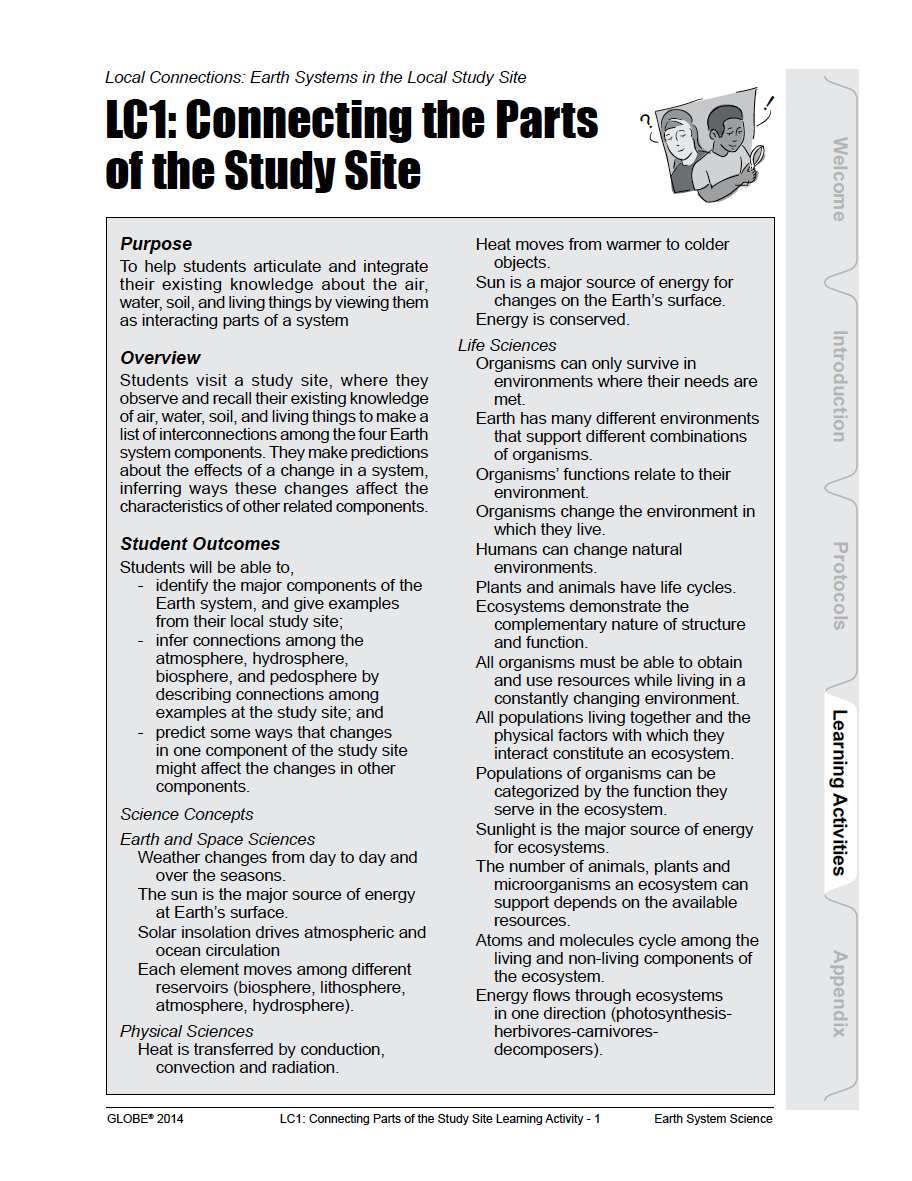Lesson Plans
GLOBE Local Connections: Earth Systems in the Local Study Site
Overview
To help students articulate and integrate their existing knowledge about the air, water, soil, and living things by viewing them as interacting parts of a system
Materials Required
- Pencils
- pads of paper with stiff backing
Optional:
- magnifying glasses
- trowels
- gloves
Preparation
- Select and visit a Phenology study site (see the Biosphere Investigation).
- Prepare students for a trip to study site.
- Make copies of Learning Activity Work Sheets:
- Recording Interconnections
- Effect of One Component on Another
- Identifying Sources for Ideas
- Understanding Earth System Concepts
- Assessment rubrics for this activity (if you wish to share them with your students)
Disciplinary Core Ideas:
- ESS1C: The History of Planet Earth
Crosscutting Concepts:
- Systems and System Models
Science and Engineering Practices:
- Asking Questions and Defining Problems
- Constructing Explanations and Designing Solutions
- Obtaining, Evaluating and Communicating Information
Students will be able to:
- identify the major components of the Earth system, and give examples from their local study site;
- infer connections among the atmosphere, hydrosphere, biosphere, and pedosphere by describing connections among examples at the study site; and
- predict some ways that changes in one component of the study site might affect the changes in other components.
Atmosphere–Hydrosphere Interconnection
- How does the presence of a stream, pond, lake, or ocean affect the air temperature nearby? (hydrosphere – atmosphere)
- How does a rainstorm affect rivers and streams?
Atmosphere–Lithosphere (Pedosphere) Interconnection
- Does the amount of moisture in the soil change? How? (atmosphere – pedosphere)
- How does the presence of large areas of rocks or asphalt affect the air temperature nearby? (Rocks are part of the lithosphere which is distinct from the soil, which is the pedosphere. Asphalt is man-made but is made up of natural materials. You can call this lithosphere – atmosphere interaction or more simply surface – atmosphere interaction)
Atmosphere–Biosphere Interconnection
- What do plants, animals, and other organisms obtain from the air? What is transported from each of those groups of organisms into the air? (biosphere –atmosphere)
- Where does heat in the soil and in the air come from? Did you know that the sun mainly warms the air only indirectly? (The soil is warmed by the sun, which heats the air, and not the other way around.) (pedosphere – atmosphere)
Hydrosphere–Lithosphere Interconnection
- Is moisture present in the soil? How does it get there? (hydrosphere – pedosphere)
Hydrosphere–Biosphere Interconnection
- How does water get from the stream (or pond, lake, canal, or ocean) to the trees? (hydrosphere – biosphere)
- How does the presence of a stream (or pond, lake, canal, or ocean) affect plants and animals? What are differences among species that live in it, species that live adjacent to it, and species that live 20 meters or more away from it? (hydrosphere – biosphere)
Biosphere–Lithosphere (Pedosphere) Interconnection
- How do leaves become part of the soil? (biosphere – pedosphere)
- Does water carry soil? When and how? (biosphere – pedosphere)
- How do plants affect the soil? (biosphere – pedosphere)
- How do animals affect the soil? Remember, there are animals living in the soil as well as on its surface. (biosphere – pedosphere)
- How do bacteria and other microorganisms affect the soil? How are they affected by the soil? (biosphere – pedosphere)
General Earth As a System Documents
- Standalone Lesson (no technology required)


